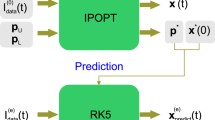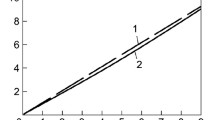Abstract
This study illustrates the application of system identification by linear programming (see page 231) to two diverse biological problems, namely incremental deep body temperature regulation in dolphins, recorded by radio telementry from a swallowed temperature sensitive transmitter, and intraocular pressure control in rabbits. An interesting result of the dolphin experiment is that the animal's internal temperature rises following a transfer from warmer to colder water. The temperature transient indicates an overshoot phenomena followed by a return to the original equilibrium temperature in approximately 1 hr. A theory of the operation of the ‘counter-flow heat exchanger’ of the dolphin is presented in conjunction with a linear model for thermal regulation. The mechanism of intraocular pressure control in a rabbit is also briefly investigated. Pressure transients resulting from injection of small amounts of fluid into a rabbit's eye are presented and a comparison is made between the formulated mathematical model and existing electrical analogs for intraocular pressure regulation. The pressure transient and model for an eye in a recently killed rabbit are significantly different from those of a live rabbit.
Sommaire
Cette étude illustre l'article relatif à l'identification de systèmes physiques par la technique de programmation linéaire (voir pages 231). Deux applications tirées du domain biologique en sont données ici; la régulation incrémentale de la température profonde du dauphin, enregistrée par télémesure à l'aide d'un émetteur thermosensible avalé, et le contrôle de la pression intraoculaire chez le lapin. L'expérimentation sur le dauphin a révélé que sa température interne augmentait quand il passait d'une eau chaude à une eau plus froide. La courbe transitoire présente un overshoot suivi d'un retour à l'équilibre initial au bout d'une heure environ. On établit un parallèle entre un modèle linéaire de régulation thermique et une théorie tirée de ce processus d'échange de chaleu paradoxal du dauphin.
De même on examine brièvement le mécanisme de contrôle de la pression intraoculaire chez le lapin. On présente le réponses transitoires de la pression consécutives à l'injection dans l'oeil du lapin de petites quatités de liquide, et on compare une expression mathématique de le modèle aux analogies électriques existantes relatives à la régulation intraoculaire. Des différences significative apparaissent entre les réponses trasitoires et le modèle d'un oeil de lapin, suivant qu'il a été récemment tué, ou qu'il est vivant.
Zusammenfassung
Diese Untersuchung illustriert die Anwendung des Verfahrens der Systemidentifizierung durch Linearprogrammierung (siehe Seite 231) auf zwei verschiedene biologische Probleme: die inkrementelle Regulation der tiefen Körpertemperatur beim Delphin, welche radiotelemetrisch durch einen verschluckten empfindlichen Temperatursender registriert wird, und die Kontrolle des intraokulären Drucks beim Kaninchen. Ein interessantes Resultat im Delphinexperiment ist der Ansteig der inneren Temperatur des Delphins, wenn das Tier von wärmerem in kälteres Wasser gebracht wird. Der Temperaturübergang zeigt ein Overshootphänomen mit nachfolgender Rückkehr zur ursprünglichen Gleichgewichstemperatur innerhalb etwa einer Stunde. Eine Theorie zur Arbeitsweise des “Gegenstrom-Wärmeaustauschers” des delphins wird im Zusammenhang mit einem linearen Wärmeregulationsmodell vorgelegt. Der Mechanismus der Kontrolle des intraokulären Drucks beim Kaninchen wird ebenfalls kurz untersuchts. Druckübergänge nach Injektion kleiner Flüssigkeitsmengen in ein Kaninchenauge werden dargestellt. Das formulierte mathematische Modell wird verglichen mit elektrischen Analogmodellen für die intraokuläre Druckregulation. Der Druckübergang und das Modell eines Auges von einem frischgetöteten Kaninchen uterscheidet sich signifikant von dem des lebenden Kaninchens.
Similar content being viewed by others
References
Adler, F. H. (1965)Physiology of the Eye, Mosby, St. Louis.
Benzinger, T. H. andKitzinger, C. (1963) The human thermostat. In.Temperature, Its Measurement and Control in Science and Industry, Vol. 3 (Part 3), Chaps. 5 and 6. Reinhold, New York.
Brengelmann, G. L. andBrown, A. C. (1963) Role of rate of change of skin temperature in human temperature regulation.Physiologist 6, 146.
Collins, C. (1966) private communication, Univ. Calif. Medical Center, San Francisco, Calif.
Crosbie, R. J. andHardy, J. D., Fessenden, E. (1961) Electrical analog simulation of temperature regulation in man.IRE Trans. Biomedical Electronics 8, 4:245.
Duke-Elder, S. (1932)Text Book of Opthalmology, Vol. 1, Henry Kimpton, London.
Hardy, J. D. andHammel, H. T. (1963) Control system in physiological temperature regulation. In:Temperature, Its Measurement and Control in Science and Industry, Vol. 3 (Part 3), p. 613, Reinhold, New York.
Kanwisher, J. andLeivestad, H. (1957) Thermal regulation in whales.Norweg. Whaling Gaz. 46, 1.
Kanwisher, J. andSundes, G. (1966) Thermal regulation in Cetaceans. In:Whales, Dolphins and Porpoises Edited by K. S. Norris. U.C. Press, Berkeley, Calif.
Langham, M. E. (1959) Influence of the intraocular pressure on the formation of aqueous humor and the output resistance in the living eye.Br. J. Opthal. 43, 705.
Macdonald, D. K. C. andWyndham, C. H. (1950) Heat transfer in man.J. appl. Physiol. 3, 342.
Mackay, R. S. (1964) Deep body temperature of untethered dolphin recorded by ingested radio transmitter.Science 144, 1620:864.
McEwen, W. K. andShepherd, M., McBain, E. (1966) Rheology of the human sclera.Opthalmologica 150, 5:22.
Morrison, P. (1962) Body temperatures in some Australian mammals III. Cetacea (Megaptera).Biol. Bull. 123, 1:154.
Parry, D. A. (1949) The structure of whale blubber and a discussion of its thermal properties.Q. J. micr. Sci. 90, 13.
Perkins, E. S. andGloster, J. (1957) Distensibility of the eyes.Br. J. Opthal. 41, 93.
Reid, M. H. andMackay, R. S. (1968) A review and discussion of some methods for system identification and modelling.Med. & biol. Engng 6, 231.
Ruch, T. C. andPatton, H. D. (1966)Physiology and Biophysics, Chap. 54. Saunders,
Schwartz, N. J. (1965) A theoretical and experimental study of the mechanical behavior of the cornea with application to the measurement of intraocular pressure. Ph.D. Thesis, Univ. of Calif, Berkeley, Calif.
Slijper, E. J. (1962)Whales. Basic Books, New York.
Young, L. R. andKupfer, C. (1965) A systems analysis view of intraocular pressure. In:6th Int. Conf. Medical Electronics in Biological Engineering, Tokyo. p. 420.
Author information
Authors and Affiliations
Rights and permissions
About this article
Cite this article
Reid, M.H., Mackay, R.S. Applications of a new technique for system identification to dolphin temperature regulation and rabbit intraocular pressure control. Med. & biol. Engng. 6, 269–290 (1968). https://doi.org/10.1007/BF02478782
Received:
Issue Date:
DOI: https://doi.org/10.1007/BF02478782




